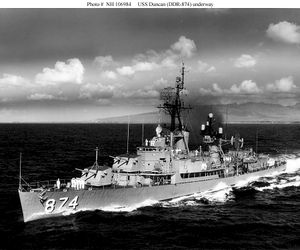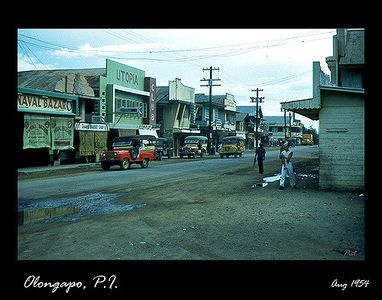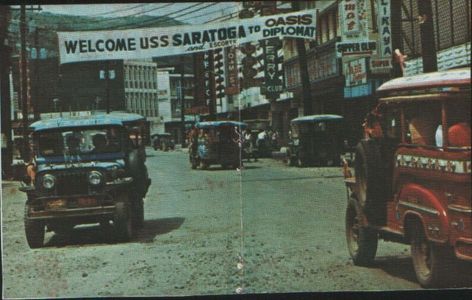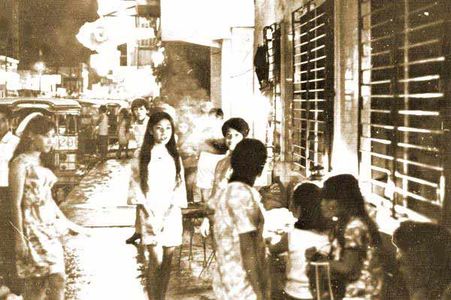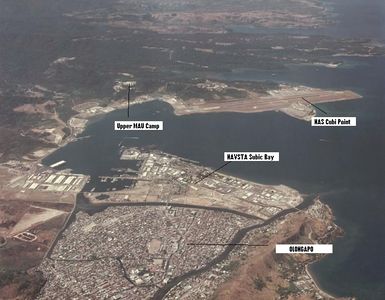Subic Bay
Subic Bay is a bay on the west coast of the island of Luzon in the Philippines, about 100 kilometers (62 mi) northwest of Manila Bay. An extension of the South China Sea, its shores were formerly the site of a major United States Navy facility named U.S. Naval Base Subic Bay, which is now the location of an industrial and commercial area known as the Subic Bay Freeport Zone under the Subic Bay Metropolitan Authority.
The bay was long recognized for its deep and protected waters, but development was slow due to the lack of level terrain around the bay.
In 1899, during the Philippine–American War, the Americans captured the Spanish base and controlled the bay until 1991. During this period, the naval facilities were greatly built up and expanded, including a new naval air station that was built in the early 1950s by slicing the top half from a mountain and moving the soil to reclaim a part of Subic Bay. In 1979, the area under American control was reduced from 24,000 hectares (59,000 acres) to 6,300 hectares (16,000 acres) when the Philippines claimed sovereign rule over the base.
A Personal Note from Robin
( What follows is a personal, non-neutral point-of-view article ! )
While I was in the US Navy, I was stationed aboard the USS Duncan, which pulled into Subic Bay Naval Station on several occasions.
Olangapo City was just a walk across the bridge from Subic Naval Station, PI. The streets which were little more than dirt roads were lined with bars, hotels, massage parlors, and clothing stores. As I remember it, you could find anything you might want and catch stuff that you didn't want to catch. A standard joke aboard ship was "Don't ever anger the medical staff. They are the ones with the stuff you want when you get stuff you don't want!"
In 1966, Subic Bay was headed by Manuel Ardonia and was the largest United States Navy installation in the Pacific at the time, and employed 15,000 Filipino civilians. The base was visited by 215 ships per month as Vietnam War activity peaked in 1967. The wild nightclubs along Ramon Magsaysay Drive between the naval base main gate and Rizal Avenue were notoriously popular among the 4,225,000 servicemen visiting the base that year. Sailors of the war remember talented Filipino musicians and singers, inexpensive San Miguel beer, attractive teenage prostitutes, erotic floor shows, Jeepney rides back to the naval base, and children diving for coins tossed from the bridge over the estuarine drainage channel in front of the naval base main gate.
Olongapo City administers itself autonomously from Zambales province. The former naval base adjacent to the city became the Subic Bay Freeport Zone in 1992
June 15, 1991, was a memorable date in Olongapo. Mount Pinatubo, 20 miles from Subic Bay erupted with a force 8 times greater than the Mt. St. Helens eruption. Volcanic ash blotted out the sun. Volcanic earthquakes and heavy rain, lightning, and thunder from a typhoon passing over northern Luzon made Black Saturday a 36-hour nightmare. This caused widespread damage to the US facility and Olongapo City.
On September 16, 1991, the Senate leaders of the Philippines did not grant an extension of the existing RP-US Military Bases Agreement between the Republic of the Philippines and the US, thus terminating the stay of US military in the Philippines.
Cubi Point Naval Air Station has been privatized and been renamed "Subic Bay International Airport"
Today, Olangapo is presented as an upscale, beautiful city, but it is the Olangapo as a 1950s port of call that I shall remember the most.
 Main article: Navy Days
Main article: Navy Days
"Sea Stories" (NOT!) |
Wikipedia links to various duty stations: |
Chat rooms • What links here • Copyright info • Contact information • Category:Root
